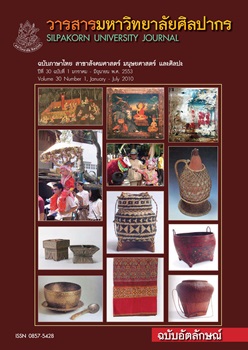ชีวิตราษฎรไทยสมัยสงครามมหาเอเชียบูรพา : มุมมองผ่านการเข้ามาควบคุมทางรถไฟสายใต้ของกองทัพญี่ปุ่น Thais’ Way of Life during the Greater East Asia War : From the Perspective of the Japanese Army’s Control of Thailand’s Southern Railways
Main Article Content
Abstract
บทคัดย่อ
บทความนี้มีวัตถุประสงค์เพื่ออธิบายให้เห็นผลกระทบจากการเข้ามาควบคุมทางรถไฟสายใต้ที่มีต่อการดำเนินชีวิตของราษฎรไทยในท้องถิ่น โดยเฉพาะจังหวัดสงขลาอันเป็นที่ตั้งของสถานีปาดังเบซาร์ ที่กองทัพใช้ในการขนส่งกำลังบำรุงจากไทยข้ามแดนไปยังมลายู รวมทั้งจังหวัดราชบุรี กาญจนบุรี ชุมพรและระนองซึ่งเป็นที่ตั้งของเส้นทางรถไฟสายไทย-พม่า และทางรถไฟสายชุมพร-กระบุรีที่กองทัพสร้างเชื่อมต่อจากทางรถไฟสายใต้ที่มีอยู่เดิมเพื่อขนส่งกำลังบำรุงไปยังพม่า ผลจากการวิจัยพบว่า ในขณะที่กองทัพญี่ปุ่นบรรลุเป้าหมายในการใช้ทางรถไฟสายใต้และทางรถไฟทหารสายใหม่ทั้งสองสายในการขนส่งกำลังทหาร อาวุธยุทโธปกรณ์ และเสบียงอาหาร เพื่อเป็นกองกำลังบำรุงให้กับกองทัพทั้งในมลายูและพม่าได้สำเร็จ แต่การเข้ามาควบคุมทางรถไฟสายใต้ของกองทัพญี่ปุ่นได้ส่งผลให้ราษฎรไทยในท้องถิ่นต้องประสบกับปัญหาการใช้เงินดอลลาร์ทหารญี่ปุ่น ปัญหาเครื่องอุปโภคบริโภคราคาสูง ปัญหาการขาดแคลนข้าวสาร และปัญหาเรื่อง “ผู้หญิงปลอบขวัญ” ของทหารญี่ปุ่น ผลของการวิจัยนี้จึงนำไปสู่ข้อสรุปที่ว่าการเข้ามาควบคุมทางรถไฟสายใต้ของกองทัพญี่ปุ่นในสมัยสงครามมหาเอเชียบูรพาเป็นกรณีศึกษาที่สะท้อนให้เห็นถึงการใช้อำนาจทางการทหารเข้ามาควบคุมและมีอำนาจเหนือในการเรียกร้องให้ฝ่ายไทยจัดหาเครื่องอำนวยความสะดวกต่อการขนส่งบนทางรถไฟสายใต้ รวมทั้งเครื่องอุปโภคบริโภคโดยเฉพาะข้าวให้กับกองทัพอย่างเร่งด่วนและต่อเนื่องตลอดสงคราม โดยไม่ได้คำนึงถึงผลกระทบที่ราษฎรไทยได้รับ
คำสำคัญ : 1. ชีวิตคนไทยในสงครามมหาเอเชียบูรพา. 2. สงครามมหาเอเชียบูรพา. 3. กองทัพญี่ปุ่น. 4. ทางรถไฟสายใต้ของไทย
Abstract
This article has the objective of explaining the impacts of the Japanese control of the southern railways on the way of life of Thai people, especially those living in Songkhla, in which the Padang Besar
Station was used to transport reinforcements from Thailand to Malaya, and the Thais living in Ratchaburi,
Kanchanaburi, Chumphon and Ranong, in which the Thai-Burma Railway was contructed to connect the
original southern railway to transport reinforcements to Burma. The study revealed that the Japanese army succeeded in using the southern railway and the other two constructed railways to transport troops, weapons, and food supplies to the Japanese soldiers in Malaya and Burma. However, the control of the southern railways had negative impacts on the local Thai people, including the use of Japanese army dollars, high price commodities, rice shortages, and Japanese soldiers’ Phuying Plopkhwan (comfort women). What can be concluded in this paper is that the Japanese control of the southern railways during the Greater East Asia War is a case study reflecting the use of military power to control and impose on Thailand sovereignty to urgently and consistently prepare transportation facilities of the southern railways and commodities especially rice for the Japanese army during the war, without taking into consideration of the negative impacts that Thai people had encountered.
Keywords : 1. Thais’ Way of Life in the Greater East Asia War. 2. Greater East Asia War. 3. Japanese Army. 4. Thailand’s Southern Railways.


